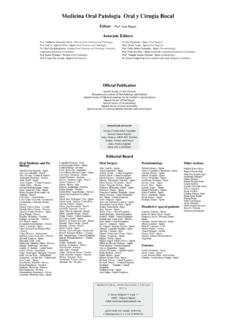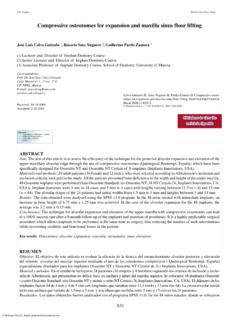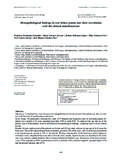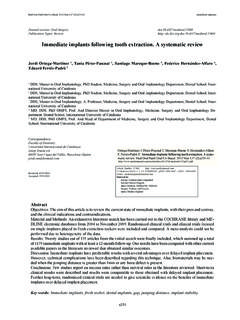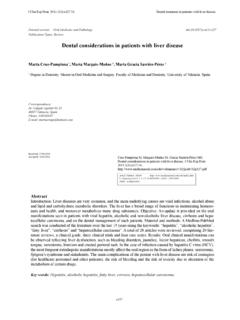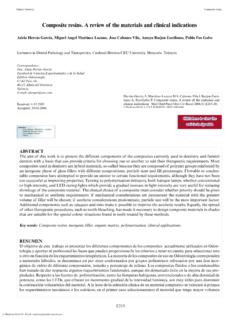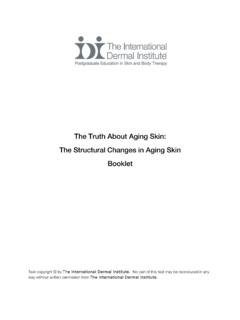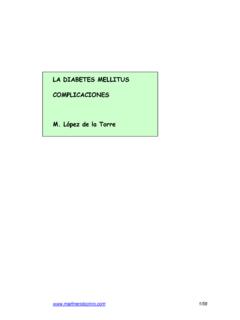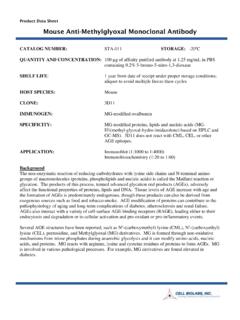Transcription of Dental considerations for the patient with diabetes
1 E25J Clin Exp Dent. 2011;3(1):e25-30. considerations diabetic section: Oral Medicine and Pathology Types: ReviewDental considerations for the patient with diabetes Silvia Mart lamo 1, Yolanda Jim nez Soriano 2, M Gracia Sarri n P rez 31 Assistant Professor Doctor. Department of Stomatology. Medicine and dentistry faculty. Valencia :San Vicente m rtir st., 102, 2046007 ValenciaE- mail: 11/06/2010 Accepted: 21/11/2010 Abstract diabetes mellitus (DM) is one of the most frequent pathologies that dentists encounter, due to its high prevalence worldwide. It is diagnosed by the repeated obtaining of fasting plasma glucose levels of 126 mg/ dl or higher, or glycosylated hemoglobin of 6 5% or higher.
2 diabetes (especially if it is not well controlled) brings with it a greater risk of periodontal disease, which is the most frequent complication. On the other hand, the possible influence of periodontal disease on glycemic control is still not well established. Other reported manifestations are xerostomia, sialadenosis and burning mouth syndrome. with regard to Dental caries, oral lichen planus and candidosis, recent studies have not revealed a significantly higher incidence in these Dental treatment, the type of diabetes suffered, the treatment given for the disease, and the glycemic control sta-tus (using the glycosylated hemoglobin test) should be known. patients should receive short morning appointments to reduce stress. The dentist has to be aware of the possible occurrence of an acute complication (hypoglycemia or hyperglycemia).
3 Furthermore, these patients suffer from delayed wound healing and major susceptibility to words: diabetes , Dental management, periodontal disease, Dental lamo S, Jim nez Soriano Y, Sarri n P rez MG. Dental consider-ations for the patient with diabetes . J Clin Exp Dent. 2011;3(1) Number: 50326 Medicina Oral S. L. B 96689336 - eISSN: 1989-5488eMail: Clin Exp Dent. 2011;3(1):e25-30. considerations diabetic mellitus (DM) is one of the most frequent pa-thologies that dentists encounter. Its clinical importance springs from the possible occurrence of acute complica-tions, whose severity could mean an immediate risk for the diabetic patient s life and require urgent diagnosis and treatment (1).DM includes a group of diseases characterized by im-paired action or secretion of insulin, or both.
4 There are four etiologic types of diabetes , although the most fre-quent are type 1 (90%) and 2 (5- 10%) (2). Prevalence of diabetes in adults worldwide was estimated to be 4% in 1995, and is predicted to rise to 5 4% by the year 2025. The countries with the largest number of people with diabetes are India, China and the In developing countries, the majority are in the age range of 45 64 years. In the developed countries, the majority of people with diabetes are aged 65 years. There are more women than men with diabetes (3).Poorly controlled diabetes could lead to complications that may even be life- threatening. Long- term compli-cations include: retinopathy, nephropathy, autonomic neuropathy, peripheral neuropathy and cardiovascular disease (2, 4).The dentist plays a major role with other members of the health team in helping a patient maintain glycemic con-trol by achieving optimal oral health; and by referring undiagnosed patients with complications suggestive of diabetes to physicians for further evaluation (5).
5 ObjectivesThe objectives of this paper are: firstly, to do a review of literature about diabetes mellitus, and the repercussions of the disease in dentistry; and, secondly, to summarize the management strategies that can be put into practice in the Dental office to treat these and MethodsFor this review, we selected articles from the PubMed- Medline database. We searched for them using key words controlled by MeSh, all of them referred to diabetes , its complications and considerations for the Dental manage-ment. The following limits were utilized: articles written in Spanish or in English and published in the 1993- 2010 period. A total of 25 articles were chosen: 8 reviews of literature (1 of them being a systematic review); 7 trans-versal studies; 2 meta- analysis; 3 panels of experts; 2 clinical cases; 1 randomized clinical assay; 1 letter to the editor and 1 case- control manifestations.
6 Periodontal disease is the most fre-quent oral complication of diabetes , as reported by L e (6) in 1993, who referred to it as the sixth complication of diabetes mellitus (the other five complications are: retinopathy, nephropathy, microvascular disease and pe-ripheral vascular disease) (4).A patient with poorly controlled diabetes has a major risk of developing periodontal disease (5, 7), which will start as gingivitis and gradually, if the glycemic control is de-ficient, this may progress to an advanced periodontitis. Diabetic children and adults without proper control of their diabetes show a tendency to present higher gingival indexes. Besides, several studies have demonstrated that patients with poorly controlled type 1 DM have more ad-vanced and severe periodontal disease than patients with an adequate glycemic control; this could be due to the association found between poorer glycemic control and elevated gingival crevicular fluid interleukin-1 (7).
7 Several mechanisms have been proposed which may explain how diabetes produces alterations in the organs and tissues, including the periodontium. First studies demonstrated that the advanced glycation end- products (AGE) synthesized due to hyperglycemia, can convert macrophages into cells with a destructive phenotype, producing high levels of interleukin-1 , interleukin 6 (IL-6) and tumour necrosis factor- (TNF- ). Moreover, AGE have the capacity to increase the endothelium per-meability and express high levels of molecular adhesion receptors. These changes could explain the greater sus-ceptibility to infections and the delayed wound healing in diabetic patients (8). This depressed immune response could explain why it may not be possible to eradicate periodontal infection totally in diabetics after conven-tional periodontal therapy.
8 This might be one of the rea-sons why antibiotics may be suggested with mechanical therapy for diabetic patients , especially for uncontrolled cases (7). By contrast, in trying to determine the capaci-ty of periodontal disease to adversely affect the control of diabetes by influencing gylcemia levels, it has been hypothesized that chronic low grade inflammations such as this might result in insulin resistance (9).Some studies report that specific treatment of periodon-tal disease in diabetic patients may improve their glyce-mic control. Nevertheless, the evidence currently availa-ble does not provide sufficient information on which to confidently base any clinical recommendations (10, 11, 12). This has motivated the preparation of a randomized and controlled trial which will provide evidence- based recommendations for clinicians (DIAPERIO trial, who-se definitive results will be published in 2013) (12).
9 The relationship between DM and Dental caries has been studied, but it has not been possible to establish a clear association between these conditions. The results ob-tained vary considerably depending on the study; some of them found a higher prevalence of caries in diabetic patients (13, 14), some found lower (15), while other re-ported no difference (16).Diabetic patients sometimes complain of having a dry mouth (xerostomia), which can be due to thirst, a fre-e27J Clin Exp Dent. 2011;3(1):e25-30. considerations diabetic be salivary dysfunction, immunosuppression and high salivary glucose levels (5). However, it is widely recognized that high salivary glucose levels in diabetic patients favour yeast growth (21).
10 DM is considered one of the systemic causes of burning mouth syndrome (BMS). The latest studies of this pa-thology suggest that the cause is a peripheral neuropathy (16). Moore et al. (22), in a study carried out on 371 adult patients with type 1 DM, concluded that the majority of diabetic patients with BMS were mainly women who had developed a peripheral neuropathy due to their DM. This, and other similarities found between BMS and the peripheral neuropathy, suggests that a neuropathic pro-cess could be the underlying cause of BMS (22). An association between DM and oral lichen planus has been described in literature, but has not been seen con-sistently in all populations of individuals with diabetes (16). For that reason, there appears to be no relationship between lichen planus and diabetes mellitus (5).
